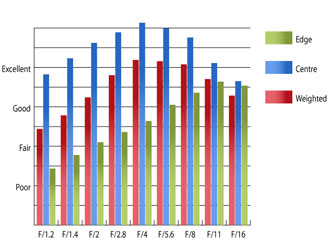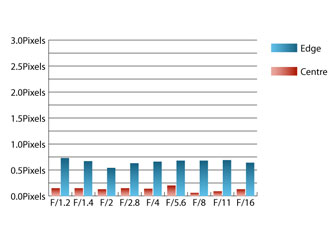Canon EF 85mm f/1.2L II USM Lens
Canon EF 85mm f/1.2L II USM: Performance
The performance characteristics of this lens make it a portrait photographer's dream as the sharpness near the centre of the frame is very good from maximum aperture. With accurate focusing, the sharp area of an image really jumps out of the frame thanks to the incredibly shallow depth of field.Unfortunately the sharpness towards the edges isn't quite as spectacular at f/1.2, but this is a highly specialised lens designed to give good results near the centre at very wide apertures, so this can be forgiven.
Stopping the lens down increases sharpness across the frame with sharpness in the centre peaking at f/4. Here the resolution is truly outstanding. The quality towards the edges of the frame continues to improve down to f/11, where the clarity is very good.
| Resolution at 85mm | How to read our graphsThe blue column represents readings from the centre of the picture frame at the various apertures and the green is from the edges. Averaging them out gives the red weighted column.The scale on the left side is an indication of actual image resolution. The taller the column, the better the lens performance. Simple. For this review, the lens was tested on an Canon EOS 5D Mark II using Imatest. | |
 |
For such a wide aperture lens, chromatic aberrations are exceptionally well controlled hovering just below 0.75 pixel widths at maximum aperture towards the edges of the frame, which should be very hard to spot, even in very large prints.
| Chromatic Aberrations at 85mm | How to read our chartsChromatic aberration is the lens' inability to focus on the sensor or film all colours of visible light at the same point. Severe chromatic aberration gives a noticeable fringing or a halo effect around sharp edges within the picture. It can be cured in software.Apochromatic lenses have special lens elements (aspheric, extra-low dispersion etc) to minimize the problem, hence they usually cost more. For this review, the lens was tested on an Canon EOS 5D Mark II using Imatest. | |
 |
Surprisingly for a large aperture lens falloff of illumination towards the corners of the frame is minimal. At f1.2 the corners are only 1.04 stops darker than the image centre and illumination is visually uniform by f/2.8.
Imatest detected 1.59% barrel distortion, which shouldn't be disturbing at all for portraiture, but may be noticeable when shooting subjects with straight lines towards the edges of the frame. The distortion pattern is completely uniform across the frame, which should make it straightforward to correct in image editing software afterwards if needs be.
A deep circular lens hood comes supplied with this optic, which does an excellent job of shielding the lens from extraneous light that may cause flare or loss of contrast. When shooting into strong light sources, such as the sun, this lens is susceptible to a reduction in contrast but it holds up well, especially for such a wide aperture lens.
Add your message
Login required
Please login here or if you've not registered, you can register here. Registering is safe, quick and free.
Please login here or if you've not registered, you can register here. Registering is safe, quick and free.
photodo Stats
1102 lenses
428 MTF tests
74 in-depth photodo reviews
100+ users join each day
Help the lens community by reviewing or rating a lens today via our lens search
428 MTF tests
74 in-depth photodo reviews
100+ users join each day
Help the lens community by reviewing or rating a lens today via our lens search
Latest Lens Reviews
- Chinon 28mm f/2.8 Vintage Lens Review
- Canon EF 70-200mm f/4L IS II USM Lens Review
- Samyang AF 85mm f/1.4 EF Review
- Sigma 70mm f/2.8 DG Macro Art Review
- Samyang AF 24mm f/2.8 FE Review
- Meike 50mm f/1.7 Review
- Tamron 70-210mm f/4 Di VC USD Review
- Lensbaby Burnside 35mm f/2.8 Review
- Asahi Super Takumar 50mm f/1.4 Review
- Asahi Super-Multi-Coated Takumar 135mm f/3.5 Review








